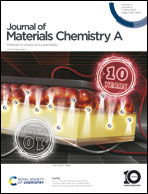A topological chemical transition strategy of bismuth-based materials for high-efficiency electrocatalytic carbon dioxide conversion to formate†
Abstract
The electrochemical reduction of carbon dioxide (ERCO2) to formate with high selectivity has been considered a promising strategy to overcome the energy and environmental crises. Bi-based materials present good application prospects, but the development of a new class of electrocatalysts with high performance remains a challenge. Herein, a novel topological chemical transition strategy is developed to rationally design highly active Bi-based materials, which are a new representative of Bi-based electrocatalysts for ERCO2. Bismuth oxysulfate (Bi2O2SO4) is prepared by a simple topological transition from the Bi2S3 precursor in air, which can further topologically transform into the metal Bi by a fast reduction treatment of NaBH4 solution. This kind of Bi2O2SO4 exhibits superior catalytic performance for ERCO2. The maximum Faraday efficiency (FE) of HCOO− is up to 97% at −0.9 V vs. RHE in an H-type cell. A high FE > 90% in a wide potential range of −0.5 to −1.2 V and a large current density of 319 mA cm−2 at −0.8 V can further be realized in a flow cell. The post-characterization studies and density functional theory (DFT) calculations confirm that the Bi2O2SO4 derived Bi catalyst has an optimal (104) plane to realize the optimized free energies of OCHO* and H* reaction intermediates, leading to superior catalytic activity over the NaBH4 derived Bi sample. Our work put forward a promising strategy to exploit advanced electrocatalysts for electrolysis.



 Please wait while we load your content...
Please wait while we load your content...